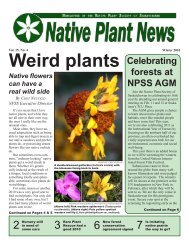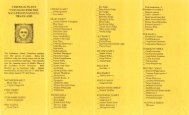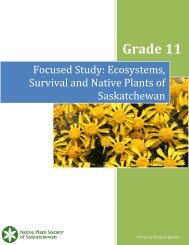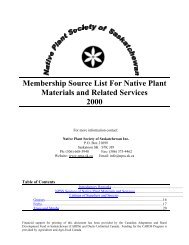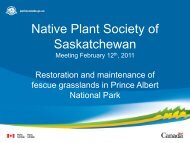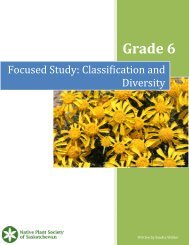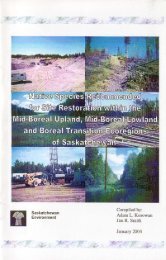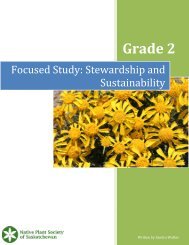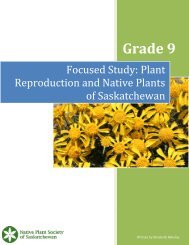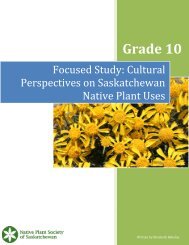Native Plants As Habitat For Wildlife - Native Plant Society of ...
Native Plants As Habitat For Wildlife - Native Plant Society of ...
Native Plants As Habitat For Wildlife - Native Plant Society of ...
You also want an ePaper? Increase the reach of your titles
YUMPU automatically turns print PDFs into web optimized ePapers that Google loves.
need control. They are susceptible to a fungal disease black knot, which may be<br />
controlled through pruning.<br />
Use:<br />
If pruned to a single trunk, they make an attractive small tree. <strong>As</strong> a large shrub they are<br />
useful in an informal shrub border, especially when seen against silver-grey foliage. They<br />
are used extensively for wildlife or shelterbelt plantings. The fruit makes an excellent jam<br />
or syrup. They provide food and cover for birds.<br />
Propagation:<br />
Seed, suckers, or cuttings.<br />
Quercus macrocarpa (bur oak)<br />
Description:<br />
<strong>Native</strong> to Manitoba and eastern Saskatchewan, it is a large, attractive, and long-lived (200<br />
years) tree <strong>of</strong> 10 m (30 ft.) or more.<br />
Bur oak has a straight trunk, high head and branchlets which <strong>of</strong>ten have corky ridges.<br />
Although it has a long standing reputation for slow growth I have seen very young trees<br />
on sandy soil put on 30cm (12 in.) <strong>of</strong> growth in a single season without supplemental<br />
water.<br />
Its leaves are typically "oak"-like, with 7 to 9 deep lobes, shiny green above and whitish<br />
and hairy below, with yellow to red fail coloration. The acorns are "mossy cup" or<br />
fringed. It has a deep root system with a wide-spreading deep tap root.<br />
Culture:<br />
Adapted to most <strong>of</strong> the prairies, the bur oak is drought-tolerant once established due to<br />
the nature <strong>of</strong> its taproot. The taproot also makes it difficult to transplant once it is over .6<br />
m (a few feet) high. This is probably the reason why it is not readily available<br />
commercially.<br />
Use:<br />
It is excellent as a shade or specimen tree in a medium or large lot. Because <strong>of</strong> its taproot,<br />
it is not competitive with nearby lawns or flowerbeds. It provides cover and food for<br />
birds.<br />
Propagation:<br />
Seed planted outdoors in the fall.<br />
43



